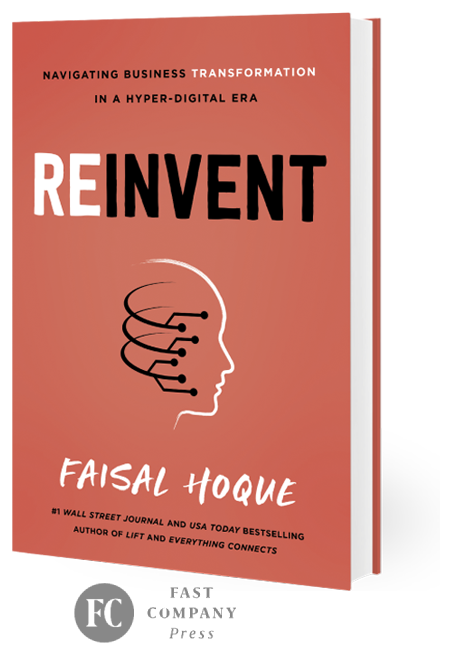Transformation means much more than plugging in new technology and flipping the switch. Leadership needs to be every bit as new and evolved.
[This article is adapted from the book REINVENT (Fast Company, 2023) by Faisal Hoque.]

The sort of sweeping digitally-based reinvention made possible by the Fourth Industrial Revolution is bursting with technological possibilities—potential that can effectively reinvent your entire organization.
But to achieve that goal, it’s essential that the optimal form of leadership be in place.
That only makes sense on any number of levels, beginning with the impact of shared commitment.
Leadership alignment and consistent commitment are critical to the success of digital transformation. Imagine a scenario where some members of management disagree or, at the very least, doubt the value of pursuing a digital reinvention. Not only can that prove problematic from the outset of the process, but persistent doubts and skepticism can also crop up later, impeding progress at a number of points. Just as destructive, that vibe can also drift down to others in an organization, effectively spreading doubt as well as confusion.
That’s a sensible first on the list of issues to resolve—making certain that leadership is consistent and sincere in their commitment to reinvention. Don’t rush the process. Hitting the pause button to ensure that leadership is aligned before embarking on a digital journey is far more constructive over the long haul, as opposed to jumping in and hoping that the skeptics simply come around.
Consider the dynamic of change as well when it applies to leadership. The current view of today’s leadership was developed to address the challenges of the Industrial Revolution more than 200 years ago. There was no talk of employee well-being, no discussion as to where employees would actually work (the factory or you might as well stay home), no interaction with customers as to new products or services and little or no attention paid to how the public viewed business ethics. Rather, it was pure hierarchy—as things needed to be done, orders were handed down and followed. Simple and authoritarian. An eighteenth century version of “My way or the highway.”
That approach doesn’t fit the shifting, evolving workplace driven by change. If nothing else, the physical reality has been utterly reinvented. Rather than factory floors buzzing with overall-clad workers, today’s workplace has been remade into an array of individual specialized departments, technology that evolves seemingly by the minute and a workforce which is increasingly offsite.
That, in turn, demands new leadership. Here are some additional items to consider to help ensure that the right form of leadership is in a position to drive reinvention:
Move away from a focus on management and toward one of leadership. The day of merely barking orders went out with rumble seats. It’s imperative to offer vision and support through a number of avenues rather than merely handing down directives. In so doing, a leader can drive disruption, help that disruption grow and flourish, and instill a similar sense of possibilities with colleagues, teammates and everyone else in an organization.
Truly understand what’s involved. As I mentioned in my book REINVENT, studies have suggested that only a small fraction of executives grasp what is necessary to achieve transformation that’s consistent with shifts in their industry and markets. It’s critical that everyone within an organization—leadership and others—have a solid grasp of what certain tools and practices actually involve.
That begins with understanding the distinctions between three terms relating to digital transformation—digitization, digitalization and digital transformation itself. You effectively have a choice among all three as to which particular strategy to pursue, so it’s critical to understand the differences:
-
-
Digitization: The most limited of the three, digitization is the process of converting information contained in physical documents from analog to digital. Simple and straightforward.
-
Digitalization: This involves leveraging technology to transform existing business models, thereby allowing organizations to use data in a more meaningful and comprehensive manner. It’s something of a step up from digitation.
- Digital transformation. Digital transformation is the most meaningful step in the digital journey. In so many words, digital transformation is all about changing the way you run your business by reorienting existing processes within a new digital avenue. It’s revisiting and reinventing everything that takes place, from internal systems to customer interaction.
-
A clear understanding of those three primary choices can help leadership not only choose the level of change that works best for them, but to fully understand what needs to be done in each case.
Help promote a digital mindset. No matter the ultimate objective, leaders are ultimately charged with fostering a mindset that effectively supports whatever initiative, project or effort may be involved. That, in turn, highlights the value of developing a digital mindset. This can effectively involve a complete makeover of how everyone within an organization approaches work, problems and challenges. Components of a digital mindset include:
-
- Walk the walk. Make certain that leadership conveys a confidence and understanding of transformation and that they live it as much as anyone else.
- Keep the rest of the organization engaged and informed. Make certain everyone is up to date and fully understands what’s taking place.
- Emphasize collaboration. This involves managing people in a way that crosses practical and organizational lines. The key word in that prior sentence is manage, not control. Collaborative leaders employ influence rather than the authority of their position to encourage, align and inspire people to perform at their very best. It’s a sense of shared purpose.
- Embrace experimentation. Promote a climate where it’s OK to make mistakes that ultimately lead to growth and progress.
Lastly, make sure you’re building a culture that lasts. A culture with solid long term prospects is characterized by everyone thinking proactively about how sustainable practices can be implemented in their teams and departments. What seems to be consistently effective in what they do? If it’s not, what can be tweaked to bolster sustainability? Look to the long term, not just the immediacy of the moment.
Reinvention means much more than plugging in new technology and flipping the switch. Leadership needs to be every bit as new and evolved to ensure that reinvention develops in a way that’s most advantageous to the organization as well as its people.
© 2022 by Faisal Hoque. All rights reserved.















